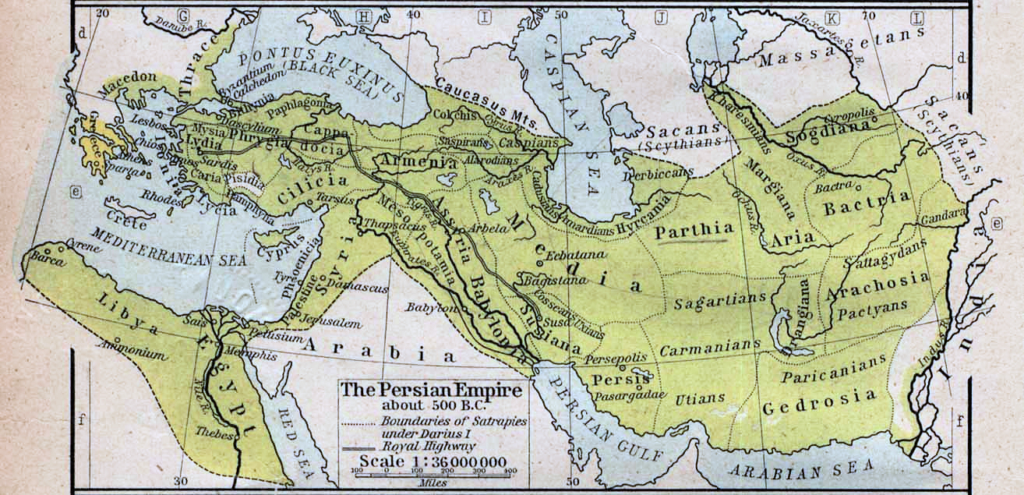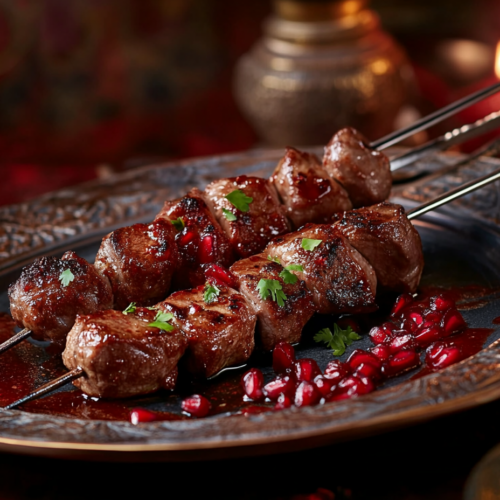The Achaemenid Empire (c. 550–330 BCE) was one of the most powerful and influential civilizations of the ancient world, known for its vast territory, advanced governance, and flourishing trade networks. At its height under Darius I (r. 522–486 BCE), the empire spanned from the Indus Valley to the Mediterranean, encompassing Egypt, Mesopotamia, Anatolia, and parts of Greece. This vast dominion brought together a mosaic of cultures, languages, and culinary traditions, making Persian cuisine a fusion of flavors from East and West.

Yet, beyond its military conquests, grand architectural feats, and administrative innovations, one of the Achaemenids’ most enduring legacies is their rich culinary heritage. The empire’s Royal Road—a 1,500-mile-long trade route connecting Sardis to Susa—facilitated the exchange of spices, grains, fruits, and livestock, ensuring that both commoners and the elite had access to a variety of ingredients. The Persian kings and nobility indulged in elaborate feasts, often accompanied by music, poetry, and fine wines, while soldiers and farmers relied on simpler but hearty meals, such as grilled meats, barley porridge, and flatbreads.
Persian cuisine during the Achaemenid period was a reflection of the empire’s expansive reach, diverse cultural influences, and access to luxurious ingredients. Food was not only a necessity but a symbol of power and prestige, particularly at the royal court in Persepolis, where banquets showcased the wealth and sophistication of the empire. Exotic ingredients such as saffron, pomegranates, nuts, and fragrant herbs were widely used, and the Persians developed a unique balance of sweet and savory flavors, which would later influence Middle Eastern and Mediterranean culinary traditions.
From the royal feasts in Persepolis to the simple meals of farmers and soldiers, Persian food was deeply tied to the empire’s prosperity, agricultural wealth, and trade routes. Even today, many elements of Achaemenid Persian cuisine—grilled meats, fruit-based sauces, and spiced rice dishes—continue to shape the flavors of modern Iranian and Middle Eastern cooking.
The Achaemenid Dynasty: An Empire of Conquests and Cultures
The Achaemenid Empire, founded by Cyrus the Great in 550 BCE, was the largest and most powerful empire of its time, stretching from the Indus Valley in the east to the Aegean Sea in the west (*Briant, P. 2002. From Cyrus to Alexander: A History of the Persian Empire). This vast territory encompassed diverse civilizations, including the Babylonians, Egyptians, Lydians, and Greeks, each contributing to the empire’s rich cultural and economic fabric. Unlike many conquerors before him, Cyrus was known not just for his military strategy but for his diplomatic skill and policies of tolerance. His governance allowed conquered peoples to retain their languages, religions, and local customs, ensuring stability across the empire’s far-reaching domains.

This multicultural approach was instrumental in shaping Achaemenid society, including its cuisine. As Persian rule expanded, it absorbed Mesopotamian baking traditions, Egyptian grain cultivation, Greek olive oil production, and Indian spices, leading to an unprecedented fusion of flavors and ingredients. Persian markets in cities like Babylon and Susa flourished, filled with imported saffron from India, dried fruits from Central Asia, and nuts from Anatolia. Cooking techniques, such as slow roasting meats over open flames and preparing fruit-based sauces, became more refined as the empire integrated culinary practices from diverse subject peoples.
Following Cyrus, his successors—Cambyses II, Darius I, and Xerxes I—not only expanded the empire’s military reach but also introduced sweeping administrative reforms that helped centralize governance and stabilize trade. Darius I, often credited as the true architect of the Achaemenid administrative system, established a standardized currency (the gold daric), an efficient tax collection system, and infrastructure improvements, including the famous Royal Road (Lendering, J. 2011. “Achaemenid Empire” in Livius.org). These advancements encouraged commerce across the empire, allowing ingredients and cooking methods to travel from one region to another, fostering an early form of globalized cuisine.
The empire’s capital cities—Persepolis, Susa, and Ecbatana—became magnificent centers of commerce, politics, and luxury, each hosting grand feasts and elaborate dining traditions. Persian kings were renowned for their extravagant banquets, where guests were treated to roast meats, fresh fruits, honeyed pastries, and spiced wines. Records suggest that these feasts were not merely indulgent displays of wealth but also political tools, solidifying alliances and reinforcing the divine authority of the Persian monarchs.
While the elite dined on saffron-infused rice, roasted lamb, and sweetened date desserts, commoners and soldiers ate barley porridge, flatbreads, and grilled meats, reflecting a diet rooted in necessity but enriched by the empire’s agricultural wealth. The Achaemenid diet was not only about sustenance but also a reflection of Persia’s dominance over trade and its ability to bring together the best ingredients from across its vast territory. This fusion of cultures and flavors laid the groundwork for what would later influence Persian, Middle Eastern, and Mediterranean cuisines for centuries to come.
Ancient Persian Cuisine: A Fusion of Flavors
Persian cuisine during the Achaemenid period was distinguished by its harmonious blend of sweet, sour, and savory flavors, a culinary tradition that would later influence Middle Eastern and Mediterranean gastronomy. Unlike many ancient cultures that relied primarily on salt and herbs to season their food, the Persians developed a sophisticated use of fruit-based sauces, aromatics, and warming spices to enhance their dishes. Among the most treasured ingredients was pomegranate, a fruit deeply tied to Persian symbolism and mythology, representing fertility, renewal, and the divine cycle of life. This ingredient was frequently incorporated into meat dishes, stews, and sauces, creating a tangy, slightly sweet contrast to rich and roasted meats.
The Achaemenid diet was a reflection of both necessity and luxury, shaped by geography, trade, and agriculture. The fertile lands of Persia, combined with its extensive trade networks, ensured access to a wide variety of grains, meats, dairy, and spices. Lamb, venison, goat, and poultry were commonly consumed, often grilled, slow-roasted, or stewed with fruit-based sauces. Barley, wheat, and rice formed the foundation of many meals, appearing in the form of pilafs, porridges, and flatbreads. The Persian nobility had access to a bounty of fresh fruits—including pomegranates, figs, dates, and grapes—which were eaten raw, dried, or used in sauces and desserts.
Dairy products such as cheese and yogurt were also staple components of Persian meals, often paired with bread and fresh herbs. The empire’s love for spices and aromatics was evident in the widespread use of coriander, cumin, saffron, and mint, all of which played an essential role in seasoning meat, vegetables, and grain-based dishes. These ingredients were not just used for flavor; they also reflected Persian knowledge of medicinal properties, with herbs and spices often incorporated into meals for their healing and digestive benefits.
One of the best representations of these culinary traditions is Muga-Anθa Himiyarhīna, or Pomegranate Glazed Lamb Skewers. This dish perfectly embodies the Persian mastery of balancing flavors, where the tender, marinated lamb is enriched by a deep pomegranate glaze, offering a contrast of tart, sweet, and savory notes. It is a dish that reflects both the practicality and sophistication of Persian cuisine, showcasing the empire’s ability to transform simple, high-quality ingredients into a meal fit for kings and warriors alike.
Eating with Empires
This dish is featured in my new digital recipe collection, Eating with Empires, which explores the iconic flavors and culinary traditions of history’s greatest civilizations. Muga-Anθa Himiyarhīna, or Pomegranate Glazed Lamb Skewers, represents the opulence and innovation of Achaemenid Persian cuisine, where sweet, sour, and savory elements were masterfully combined. With ingredients sourced from the vast trade networks of the Persian Empire, this dish embodies the flavor balance that defined Persian royal feasts. Eating with Empires brings recipes like this to life, offering a historical journey through food, allowing you to cook and experience the meals that shaped civilizations.
Recipe: Muga-Anθa Himiyarhīna (Pomegranate Glazed Lamb Skewers)

Persian Pomegranate Lamb Skewers
Ingredients
For the Marinade:
- 1 lb lamb or venison cubed
- ½ cup red wine or grape juice for a non-alcoholic version
- 2 tbsp red wine vinegar
- ¼ cup pomegranate juice freshly squeezed if possible
- 1 tbsp olive oil
- 1 tsp sea salt
- ½ tsp black pepper
- ½ tsp coriander seeds ground
- ½ tsp cumin
- 2 cloves garlic crushed
For the Pomegranate Glaze:
- ½ cup pomegranate juice
- 1 tbsp honey or date syrup
- ½ tsp cinnamon
For Assembly & Garnish:
- 4-6 wooden skewers soaked in water for 30 minutes
- Fresh herbs cilantro or mint for garnish
- Flatbread Taftoon or barley porridge (Muga-Hudā) for serving
Instructions
Marinate the Meat:
- In a bowl, mix wine, vinegar, pomegranate juice, olive oil, garlic, salt, pepper, coriander, and cumin. Add the cubed lamb or venison, ensuring it’s evenly coated. Cover and let marinate for at least 2 hours, or overnight for deeper flavor.
Prepare the Glaze:
- In a small pot, combine pomegranate juice, honey, and cinnamon. Simmer over low heat until it reduces into a thick glaze (about 10 minutes). Set aside.
Skewer & Grill:
- Thread the marinated lamb onto skewers. Grill over medium-high heat for 8–10 minutes, turning often for even cooking. Brush with the pomegranate glaze in the last 2 minutes of grilling to create a flavorful, caramelized coating.
Serve & Garnish:
- Sprinkle with fresh cilantro or mint. Serve with flatbread (Taftoon) or barley porridge (Muga-Hudā) for an authentic Persian dining experience.
Video
Notes
- Marination is key – Allowing the lamb or venison to marinate for at least two hours (or overnight) enhances the depth of flavor and ensures tender, juicy skewers.
- Grilling alternatives – If a grill isn’t available, the skewers can be cooked under a broiler or pan-seared on a stovetop with excellent results.
- Authentic pairing – Traditionally, this dish would have been served with barley-based dishes and fresh herbs, but it also pairs well with modern rice pilafs or Persian-style flatbreads for a contemporary take.
